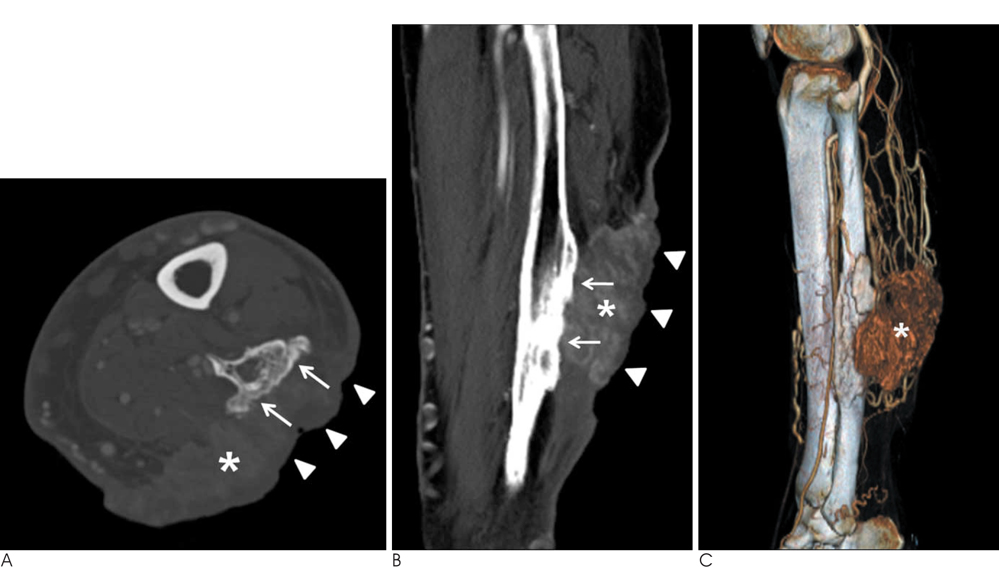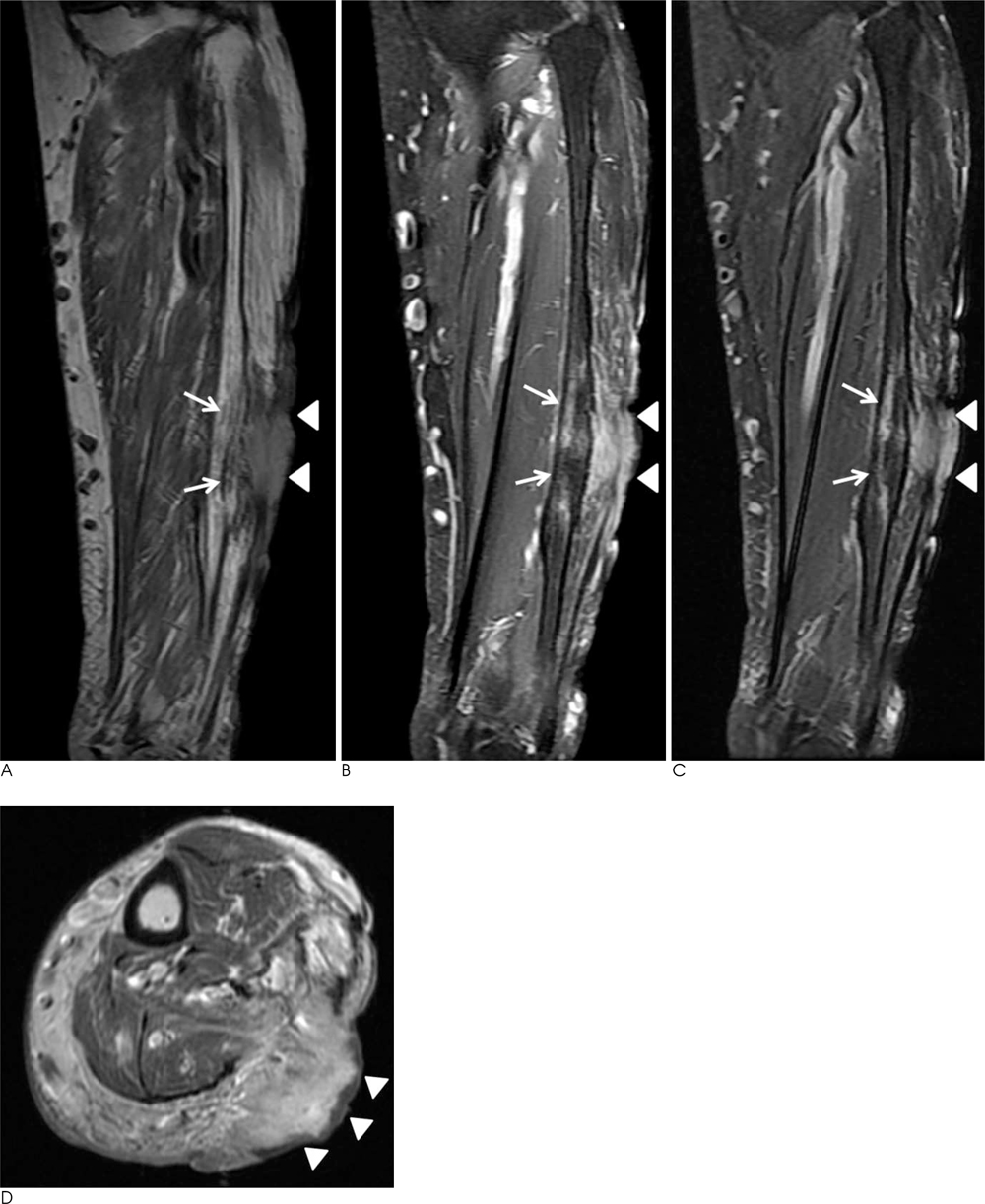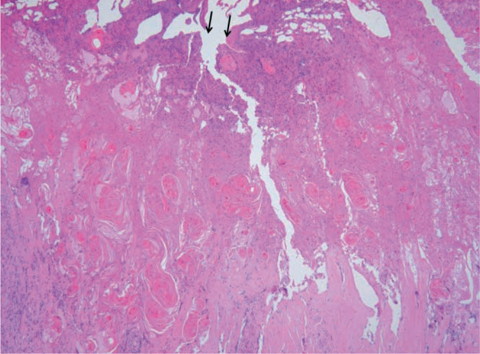J Korean Soc Radiol.
2011 Jun;64(6):593-598. 10.3348/jksr.2011.64.6.593.
Imaging of a Marjolin's Ulcer: A Case Report
- Affiliations
-
- 1Department of Radiology, Soonchunhyang University Hospital, Bucheon, Korea. mj4907@schmc.ac.kr
- 2Department of Orthopedics, Seoul SKY Hospital, Korea.
- 3Department of Pathology, Soonchunhyang University Hospital, Bucheon, Korea.
- KMID: 1443510
- DOI: http://doi.org/10.3348/jksr.2011.64.6.593
Abstract
- A Marjolin's ulcer refers to malignancies that developed in chronic venous ulcers, scars, or sinuses. We report three-dimensional computed tomography (CT), magnetic resonance imaging (MRI), and positron emission tomography (PET)-CT findings in a patient who developed skin cancer from a chronic leg ulcer. Although rare, on MR, a Marjolin's ulcer should be considered when a well-enhanced soft-tissue mass with a broad based skin ulcer shows a mass effect and invasion of the adjacent bone. CT angiography and PET-CT complement MRI for evaluating the nature of Marjolin's ulcers and may provide essential anatomical information, enabling the physician to design the optimal surgical approach or determining cancer staging.
MeSH Terms
Figure
Reference
-
1. Smith J, Mello LF, Nogueira Neto NC, Meohas W, Pinto LW, Campos VA, et al. Malignancy in chronic ulcers and scars of the leg (Marjolin's ulcer): a study of 21 patients. Skeletal Radiol. 2001; 30:331–337.2. Chiang KH, Chou AS, Hsu YH, Lee SK, Lee CC, Yen PS, et al. Marjolin's ulcer: MR appearance. AJR Am J Roentgenol. 2006; 186:819–820.3. Rieger UM, Kalbermatten DF, Wettstein R, Heider I, Haug M, Pierer G. Marjolin's ulcer revisited--basal cell carcinoma arising from grenade fragments? Case report and review of the literature. J Plast Reconstr Aesthet Surg. 2008; 61:65–67.4. Kolawole TM, Bohrer SP. Ulcer osteoma-bone response to tropical ulcer. Am J Roentgenol Radium Ther Nucl Med. 1970; 109:611–618.5. Karasick D, Schweitzer ME, Deely DM. Ulcer osteoma and periosteal reactions to chronic leg ulcers. AJR Am J Roentgenol. 1997; 168:155–157.6. Pretorius ES, Fishman EK. Volume-rendered three-dimensional spiral CT: Musculoskeletal applications. Radiographics. 1999; 19:1143–1160.7. Shin DS, Shon OJ, Han DS, Choi JH, Chun KA, Cho IH. The clinical efficacy of (18)F-FDG PET/CT in benign and malignant musculoskeletal tumors. Ann Nucl Med. 2008; 22:603–609.8. Feldman F, van Heertum R, Manos C. 18-FDG PET scanning of benign and malignant musculoskeletal lesions. Skeletal Radiol. 2003; 32:201–208.9. Aoki J, Watanabe H, Shinozaki T, Takagishi K, Tokunaga M, Koyama Y, et al. FDG-PET for preoperative differential diagnosis between benign and malignant soft tissue masses. Skeletal Radiol. 2003; 32:133–138.10. Fleming MD, Hunt JL, Purdue GF, Sandstad J. Marjolin's ulcer: a review and reevaluation of a difficult problem. J Burn Care Rehabil. 1990; 11:460–469.
- Full Text Links
- Actions
-
Cited
- CITED
-
- Close
- Share
- Similar articles
-
- Marjolin's Ulcer Secondary to Tuberculous Tenosynovitis of the Wrist: A Case Report
- A clinical analysis of the marjolin's ulcer
- Marjolin's Ulcer Presenting with In-Transit Metastases: A Case Report and Literature Review
- Squamous Cell Carcinoma Occurring at the Site of an Arteriovenous Fistula Ulcer: A Case Report
- Outcomes of Treatment for Squamous Cell Carcinoma Originating as a Marjolin's Ulcer






